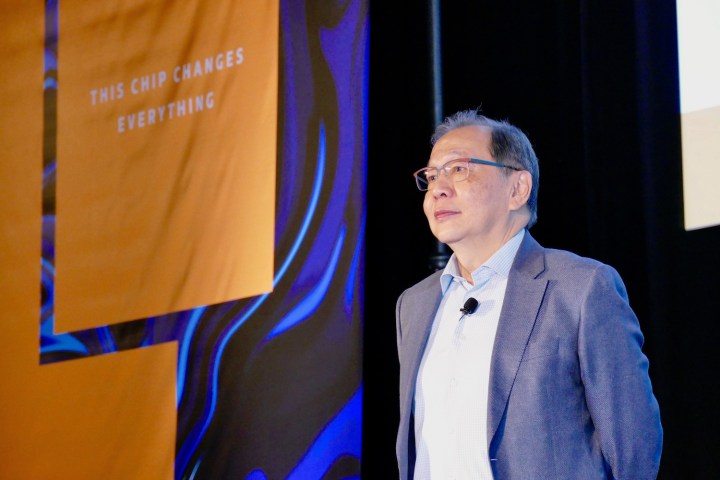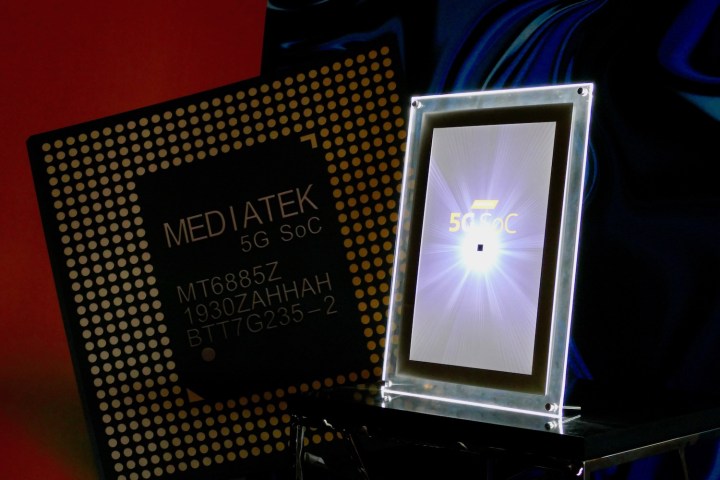
MediaTek CEO Rick Tsai said one of the best pieces of advice he has ever received was to “do the right things, right.” It was such good advice, he said, that he has repeated it to others many times over the years. What’s interesting is how this adage is clearly influencing how MediaTek has progressed over the past couple of years. In a chat with Digital Trends, just before the start of the MediaTek Summit in San Diego at the beginning of November, Tsai talked about this change, how it fixed previous problems that held the company back, and the importance of its new 5G SoC chip.
The quiet giant
Tsai is relaxed, humble, amiable, and very easy to talk to, and his focus, knowledge, and commitment come through immediately as the conversation starts. He joined the company just over two years ago, after heading up Taiwanese manufacturing company TSMC, best known for supplying Apple with its chipsets. MediaTek wasn’t in great shape at the time, he admits, but underneath was a firm with strong technical ability that struggled to bring manufacturing, sales, marketing, and other teams together to make a cohesive, successful product. Changes took place under Tsai’s guidance, and MediaTek’s true capability has come out.
“There is a certain perception of MediaTek, in the industry and the press, of it being a quiet, large-volume producer with good quality and good pricing,” he told Digital Trends. “That’s all fine. But the last two or three years has been a difficult period. But we got out of that, and transformed ourselves. I want MediaTek to be known not just as a quiet, behind-the-scenes mass producer. We need to build a brand.”
“When I am asked what are my proudest moments, this is one of them.”
To do this, MediaTek doesn’t just need a headline-grabbing product; it needs the right product for right now, built to the absolute best of its ability. That product is the Dimensity 1000 5G chip. The new chip, as well as the planned family of other 5G chips coming next year, is the result of MediaTek’s transformation. Described as having the world’s most advanced 5G SoC architecture, the chip is packed with world firsts, and comes at a time when the smartphone world is gearing up for a giant 5G push. It’s undeniably impressive, quite unlike anything MediaTek has released in the past, and Tsai’s eyes glinted when he said, “When I am asked what are my proudest moments, this is one of them.”
Focus on 5G
Announced earlier this year, MediaTek’s partners are already building prototype phones using the Dimensity 1000 5G SoC, and Tsai has a laser focus on its rollout plan.
“We will ship in December, and then from the beginning of next year, there will be a major offensive,” he said. “Starting January, and every month after, we’re going through a ramp for the whole year. It’s going to be a major thing for us. We have a second chip which will be in production early second quarter, and a third chip sometime in late third quarter or early fourth quarter.”

The opportunity with 5G is huge, and MediaTek is not wasting time. Smartphones powered by the first version of the Dimensity 1000 will arrive in the U.S. and Europe during the second half of 2020, but China will get them first. Tsai knows China’s big four brands — Xiaomi, Vivo, Oppo, and Huawei — want to push 5G from the very high end, to the mid, and then to the mainstream as soon as they can.
“They compete with each other fiercely,” he said. “We work with them closely, understand their needs, and that’s why we have three 5G chips in our portfolio.”
The first Dimensity 1000 chip, set to ship at the end of this year, will be for high-end smartphones. MediaTek’s follow-up, set to arrive during the second quarter of 2020, will be designed for phones that cost around $360 locally. The third Dimensity 1000 chip is for phones priced around $280 and will launch at the end of the third quarter. China’s main cell carriers launched 5G at the end of October and the demand for 5G phones will only increase — but don’t expect exceptionally cheap 5G phones just yet. Tsai predicts that phones priced around $220 locally in China won’t be possible in 2020.
This is only the beginning for MediaTek’s 5G chip plans. “There are more in the pipeline,” Tsai confirmed.
Since we spoke, the company has announced a partnership with Intel to build Dimensity 5G chips for computers. MediaTek is seeing a change in the response from its partners too. “It’s totally different from previous times,” he said. “It’s the first time they want to do co-marketing, for example. This time we really surprised people. I think we turned a corner, but we are not out of the woods.”
4G provides lessons for 5G
How did this come about when, by MediaTek’s own admission, it didn’t manage to capitalize on the 4G wave?
During his opening keynote at the MediaTek Summit, Tsai described 4G as a, “difficult experience for the company,” adding that it must do better with 5G or risk becoming irrelevant.
“We struggled with 4G,” Tsai told Digital Trends. “We did fairly well over the past two years [with 4G], but it’s past its prime in the cycle. We came out with a good modem, and good SoCs, and we grabbed market share, but it was all just compensation. But this is past tense. With 5G, we are determined. We want to be in the leadership group, and with this new chip, we executed. We are shipping our first design as a product.”
The improvements MediaTek made to its later 4G modems helped make the 5G modem better. “Our 4G modem is really good,” Tsai said, smiling before adding, “but it was after two or three tries.”
The fundamentals
When Tsai joined the firm, the 5G modem was being worked on by around 200 people, and now, at the end of 2019, there are more than 4,000 people working on it. MediaTek was involved in creating the 5G standards, so it knows the technology intimately. Despite this, Tsai says the major difference at MediaTek now, as opposed to two years ago, is that it has grasped “the fundamentals.”
“I was not sure they were there before. Now, if we don’t have the fundamentals in place, I beat people up for that,” he joked. “The branding can be great, but without the fundamentals, it’s a mirage.
“The modem is a good example. We still have things we can do to optimize the architecture, but we know overall it’s strong. Our protocols are solid. Our download speeds are very good, and our power consumption is better than anyone’s.”

Tsai considers the product road map to be fundamental too, and is now working on a clearer, balanced, and more diverse one that can adapt to industry changes over time. Smartphone chips only make up about 35% of its business, while smart home chips take up another similarly sized chunk, with connectivity chips and those used in data centers making up the remainder. You might be surprised to learn that MediaTek’s chips are inside most Amazon Echo and Fire products, 70% of smart TVs, and even the Peloton exercise bike.
With a balanced product road map and a focused plan for 5G, MediaTek has found much-needed direction, but this did not come easily.
Guiding MediaTek
“When I joined the company, I spent a lot of time on smartphones, and that was where we had the most problems,” Tsai recalls. There, he implemented weekly meetings to discuss issues raised by partners with research and development teams, marketing teams, and sales. Complicated and time-consuming, Tsai said this was an “alignment process,” and it brought about a crucial change in company direction. These meetings continued with the more complex and important Dimensity 1000, but the atmosphere is “like night and day,” he told Digital Trends.

“The meetings now aren’t the same. Problems now are worked through proactively, and as the fewer, final issues are discovered, the right resources can be allocated much more effectively. The key is to make sure everyone knows where we are going. Quarrels still happen, but in an aligned manner,” Tsai said.
Finding a direction is a crucial breakthrough for MediaTek, which has sometimes struggled to communicate externally what it does and where its going, let alone internally. It has a diverse set of products and separate managers for each division. Tsai talks about them glowingly before emphasizing a key point.
“One thing I want to make sure everyone knows,” he pointed out in relation to MediaTek’s turnaround, “is it’s not just me. It’s all the executives, the R&D team, everyone. I’m just a speaker for them. We have a talented team. We just had to rise to the challenge. This happens once we know where to go. The Dimensity team is clearly aligned with where they’re going.”
“The meetings now aren’t the same … Quarrels still happen, but in an aligned manner.”
Tsai seems certain MediaTek is now providing the right products — and producing them in the right way. It hasn’t been easy, but sticking to that valuable piece of advice seems to be working out well for himself, and for MediaTek.



